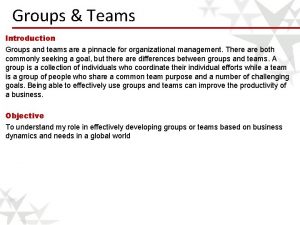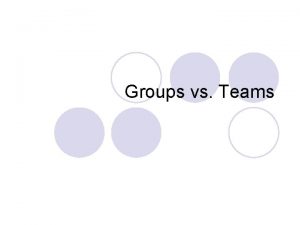Chapter 6 GROUPS and TEAMS Teams vs Groups







- Slides: 7

Chapter 6 GROUPS and TEAMS

Teams vs. Groups Teams: • - Shared leadership roles and collective work-product • - Rely on individual accountability and on mutual accountability. Groups: • - Strong, clearly-focused leadership and individual work product • - Rely on individual accountability only

The Power of Teams Five Key Principles: (1) a meaningful common purpose that the team has helped shape (2) specific performance goals that flow from the common purpose (3) a mix of complementary skills (4) a strong commitment to how the work gets done (5) mutual accountability.

Conflict Management • Conflict is inevitable • Conflict can be a positive experience • A natural and beneficial by-product of diversity and good organizational culture • Conflict is a variation of wants, needs, ideas and expectations • Conflict Management is essential to Group and Team Process

Resolving Conflict • Step One: Understand the cause • Step Two: Recognize the intensity • Step Three: Strategies to address the conflict: - Competing - Accommodating - Avoiding - Compromising - Collaborating

Leveraging Teams The Sequential Problem Solving: • Emphasizes logical, sequential analysis within known parameters • Results in incremental changes Connective Problem Solving: • Combing varied knowledge in novel way and moving beyond existing boundaries/rules • Results in radical

The Super Team • Organizationally distinct units tightly integrated as the senior executive level • Leverage vital group processes, structures and exploit the advantage of separate cultures with remarkable and radically innovative results. • “Ambidextrous organizations” • Breakthrough products or services













